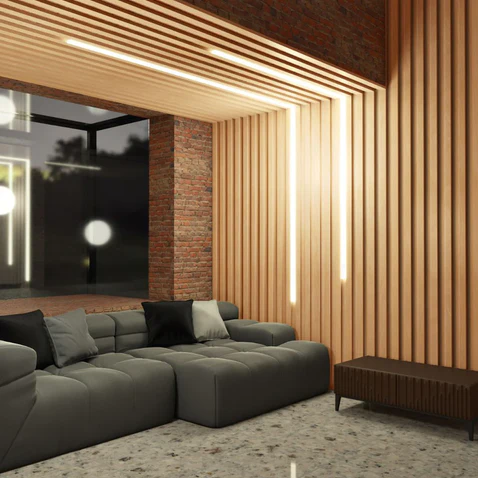At Haibo Wall Panel Factory, we understand that wall panels are more than just decorative surfaces—they are an integral element of modern interior design. A well-chosen panel can transform a plain wall into a statement piece, set the tone of a room, or create visual flow between different areas. From enhancing acoustics and insulation to adding texture and depth, wall panels serve both functional and aesthetic purposes.
Coordinating panels with other design components like flooring, furniture, and lighting requires a thoughtful approach. The right combinations not only elevate the style of a space but also improve comfort and usability. This article will guide you through practical ways to pair wall panels with various design elements, helping you achieve interiors that feel balanced, cohesive, and visually striking—with insights built on the product expertise from Haibo Wall Panel Factory.
1.Understanding Wall Panels: Material, Texture, and Finish
To create harmony within any space, it's important to begin with a clear understanding of what wall panels are made of and how their textures and finishes influence interior mood. At Haibo Wall Panel Factory, we produce panels using a wide range of materials—each offering its own visual and tactile characteristics.
When wall panels are selected thoughtfully based on material and finish, they can serve as a subtle backdrop or the focal point of a room.
For example, a matte-finished wood composite panel may bring understated elegance to a minimalist space, while a high-gloss PVC panel can amplify light in compact or low-light areas.
Below is a quick comparison of commonly used panel materials and their pairing potential:
| Material Type | Surface Texture | Ideal Finish | Suggested Pairings |
|---|---|---|---|
| PVC | Smooth or grooved | Glossy or matte | Modern kitchens, bathrooms, utility spaces |
| MDF (Medium-Density Fiberboard) | Smooth | Painted or laminated | Living rooms, bedrooms, feature walls |
| WPC (Wood-Plastic Composite) | Woodgrain-textured | Natural or coated | Hallways, retail interiors, café settings |
| Aluminum composite | Sleek, metallic | Brushed or polished | Offices, elevators, commercial entrances |
Textures also play a psychological role. Rougher surfaces such as stone-like or embossed panels tend to feel grounding and rustic, whereas ultra-smooth finishes suggest cleanliness and precision. Depending on whether your space needs warmth, depth, or brightness, Haibo Wall Panel Factory offers finish customizations to suit the look you’re after.
As we explore how to match these panels with your surroundings, understanding the material and surface finish gives you the foundation for every styling decision to follow.
2. Color Coordination: Matching Wall Panels with Existing Interior Style
Color plays a defining role in how a space feels—inviting or stark, expansive or cozy, balanced or chaotic. Choosing the right wall panel color to match your existing décor is more than a design decision; it’s a tool for shaping perception and flow in any room.
Start by identifying your space’s dominant color tones.
Are your floors warm-toned wood? Do your curtains lean toward cool grays or beige neutrals? Understanding whether your current palette is warm, cool, or neutral helps guide wall panel choices. For example, warm-toned oak flooring pairs effortlessly with beige or soft terracotta panels, while cooler ceramic tiles may benefit from white, light gray, or even muted green wall panels.
-
Monochromatic color schemes—where wall panels are a shade lighter or darker than adjacent surfaces—create a sleek, cohesive aesthetic. In contrast, complementary color schemes (like navy panels against a tan sofa or sage green against a cream wall) offer subtle contrast and depth without visual clutter.
Lighting also affects how panel colors appear throughout the day. Natural light amplifies brightness and may wash out pale colors, while artificial lighting can cast yellow or blue hues, changing how panels are perceived. It’s smart to test swatches under both lighting conditions before making a final decision.
Ultimately, your choice should support the atmosphere you want to create—tranquil, vibrant, elegant, or cozy. Wall panels are not just decorative cladding; they set the tone for the entire environment when properly aligned with existing furnishings and color schemes.
3.Ceiling and Floor Pairings: Harmonizing Surfaces
While wall panels are often chosen for their visual appeal, their full potential is realized only when thoughtfully coordinated with ceilings and floors. A harmonious connection among these surfaces creates a well-balanced atmosphere—whether that’s cozy, modern, rustic, or minimalist. Choosing the right combinations ensures that no single element looks out of place.
At its core, surface harmony is about visual flow. For example, pairing a textured walnut panel with a matte-finish ceiling and matching dark-wood flooring can create a grounded, intimate living space. On the other hand, using light-colored PVC panels with a high-gloss ceiling finish and pale oak floors can achieve a bright and spacious aesthetic.
Case Study 1: Urban Apartment with Limited Natural Light
Goal: Brighten the space without overloading it with artificial tones
Solution:
• Wall Panels: Off-white embossed PVC with slight sheen
• Ceiling: Satin white with minimal lighting grooves
• Floor: Bleached wood-effect vinyl tiles
Result: The blend of soft neutrals lifted the room visually while maintaining a warm, livable character.
Case Study 2: Family Dining Room with High Ceilings
Goal: Soften the echo and add warmth without making it feel smaller
Solution:
• Wall Panels: Horizontal cherry woodgrain PVC panels
• Ceiling: Matte taupe with central chandelier mount
• Floor: Medium-tone engineered wood with visible grain
Result: The horizontal flow of the panels balanced the vertical height, creating an inviting and acoustically comfortable space.
When working with various textures and finishes, it’s often helpful to limit your palette to three core tones and introduce contrast through sheen or grain, rather than color alone. For instance, combining a matte ceiling with semi-gloss wall panels adds depth without overwhelming the room. Likewise, when working with patterned panels, pairing them with neutral floors and ceilings allows the wall to stand out as the feature surface.
Ultimately, successful ceiling and floor pairings anchor the wall panel design and ensure your room feels like a unified space—not a collection of mismatched surfaces. Let your panel selection lead the way, and build the rest of your surface plan to support and elevate that foundation.
4.Wall Panels and Mixed Material Design
Combining wall panels with other materials like wallpaper, paint, and tile adds depth, texture, and personality to a space. Smooth, matte panels work well with bold wallpaper patterns, while neutral wallpaper can soften textured panels. Paint offers flexibility to complement or contrast panels, enhancing texture or creating harmony. Tiles bring durability and style, especially in kitchens and bathrooms, when paired with panels designed for moisture resistance. Successful mixed-material design balances color palettes and textures to ensure a cohesive and intentional look.
-
The key to success in mixed material design is cohesion. Keeping a consistent color palette and balancing bold textures with neutral surfaces ensures the space feels intentional rather than chaotic. Using similar undertones or repeating a color across materials can tie the look together seamlessly.
| Material Combination | Recommended Usage Areas | Design Tips | Maintenance Notes |
|---|---|---|---|
| Wall Panels + Wallpaper | Living rooms, bedrooms | Use panels low and wallpaper above for balance | Wallpaper sensitive to moisture, avoid damp areas |
| Wall Panels + Paint | Offices, hallways, lounges | Match or contrast colors to emphasize texture | Paint allows easy refresh, panels require gentle cleaning |
| Wall Panels + Tile | Kitchens, bathrooms, entryways | Use panels for impact zones, tiles for splash areas | Ensure moisture resistance, proper sealing essential |
By thoughtfully combining wall panels with paint, wallpaper, and tile, you can create spaces that are visually rich, functional, and uniquely yours.
5.Lighting and Wall Panels: Creating the Right Mood
Lighting plays a crucial role in highlighting the texture and finish of wall panels. Proper lighting can bring out subtle details or create dramatic effects that change the perception of a room. Techniques such as backlighting, wall washing, and focused spotlights allow panels to become dynamic design elements rather than static surfaces.
Panels with three-dimensional textures respond best to side or angled lighting, which casts shadows and emphasizes depth.
For example, a panel with carved geometric patterns will reveal its full character when illuminated from the side, while flat panels benefit more from soft, even lighting.
Consider how lighting changes throughout the day. Natural light softens textures and tones, while artificial light can be adjusted to create cozy warmth or crisp clarity. Case studies show that the same panel can feel rustic and inviting under warm, diffused light, yet modern and sleek under cooler, direct lighting.
Planning your electrical layout with your wall panel installation in mind is essential. Avoid placing outlets or fixtures that could damage panels or interrupt patterns. Early coordination helps prevent costly repairs or compromises to the visual flow.

6. Accessorizing with Art and Decor
Adding art and decorative items to wall panels can enhance a space without overwhelming it, but care is needed to maintain harmony. Hanging artwork directly on panels requires appropriate anchors that do not damage the material or leave permanent marks.
Some wall panels feature grooves, recesses, or raised lines that serve as built-in design elements. These can reduce the need for additional decorations by offering visual interest through texture alone. Using these natural lines creatively can also help position decor items symmetrically or asymmetrically.
Mirrors, clocks, and plants are popular accessories that complement wall panels well. Mirrors can reflect light and make spaces feel larger, clocks add function and style, while plants introduce softness and a natural touch. Integrating these accessories with panel design elements enhances rather than competes with the wall.
7. Room-by-Room Styling Guide
Different rooms have unique demands for wall panels based on their function and environment:
• Living Rooms: Opt for panels with warm textures and finishes that invite relaxation. Acoustic panels may help reduce echo.
• Bedrooms: Soft finishes and neutral colors promote tranquility. Panels with fabric or leather textures add comfort.
• Bathrooms and Kitchens: Waterproof and easy-to-clean panels are essential. Glossy or smooth surfaces resist moisture and stains.
• Entryways and Hallways: Durable panels that withstand traffic, paired with reflective finishes to brighten these transition spaces.
• Offices: Panels that combine sound absorption with sleek design enhance productivity and professionalism.
Consulting designers or architects can help tailor panel selection to each room’s requirements, balancing aesthetics and practicality.
8. Maintenance and Longevity Tips to Keep Panels Looking Fresh
Proper care ensures your wall panels maintain their appearance and performance over time. Different materials require specific cleaning methods:
• Use a soft, damp cloth or microfiber duster for routine dusting.
• Avoid harsh chemicals; opt for mild, non-corrosive cleaners suitable for your panel’s finish.
• Vacuuming is useful for fabric or textured panels to remove dust buildup.
Routine maintenance can be supplemented with professional cleaning every few years, especially in high-traffic or humid environments.
Protect vulnerable edges and corners with skirting boards, trims, or metal corner guards. These accessories help prevent chipping and wear, preserving the panel’s integrity and visual appeal.
Connect Us
Wall panels offer incredible versatility in transforming interiors, blending beauty with function. From material choices and color coordination to lighting and maintenance, every decision shapes the way panels interact with their environment.
Finding a balance between aesthetics and practicality allows spaces to feel both stylish and livable. For those seeking tailored solutions and expert guidance, Haibo Wall Panel Factory stands ready to provide high-quality, customizable panels that meet diverse design needs. With thoughtful pairing and care, wall panels become more than surfaces—they become defining features of your space.

 English
English русский
русский Français
Français Español
Español bahasa Indonesia
bahasa Indonesia عربى
عربى



